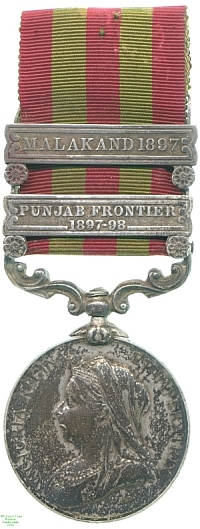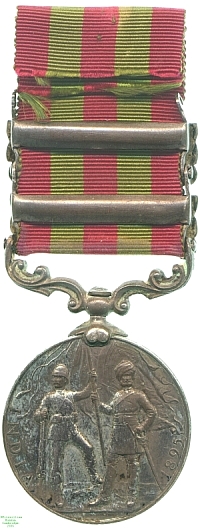
Obverse, a bust of Queen Victoria

Reverse, a British and an Indian soldier supporting a standard together

Obverse, a bust of Queen Victoria |

Reverse, a British and an Indian soldier supporting a standard together |
By 1895 it was beginning to be considered that the 23 bars issued to the India General Service Medal implied a need for its replacement, and in 1896 the new India Medal was first issued.
The North-West Frontier between British India and Afghanistan was a source of political tension for the length of the nineteenth century and beyond, as the precarious Imperial accommodations with local tribes required continual maintenance. In 1893 an agreement between the British in India and the rulers of Afghanistan instituted the Durand Line as a working frontier. This left many Pashtun tribal groups on the now-British side of the border, and the British found themselves unable to enforce any control over these unruly new subjects. In 1897 several parts of the Frontier rose in rebellion at once, all seeing an opportunity in a Pashtun rising which began the fighting. This rising left Imperial forces in the frontier forts of Chakdara and Malakand (both now in Pakistan) besieged against heavy odds until relief could reach them. At Malakand 1000 Sikhs successfully held off forces 10 times their number. British retaliation, due to the urgent situation, was unusually destructive, as despatches from the young Winston Churchill, in the force that relieved Chakdara, to the Daily Telegraph made clear at the time.
This medal was awarded to Sapper Munisami of the Queen's Own Madras Sappers & Miners, who was wounded by gunshot in the defence of Malakand. Despite his wounds he also managed to take part in the arduous campaign against the Afridi rising around Peshawar later in 1897, earning him his second bar. Lester Watson purchased his medal at some point before 1928.